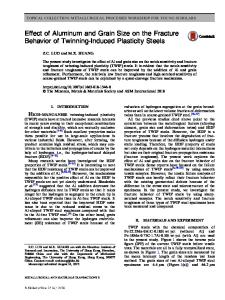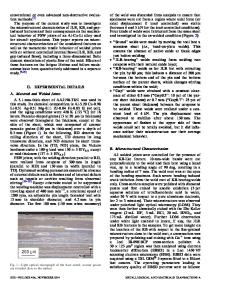Effect of Welding Parameters on Junction Structure and Fracture Behavior of Friction-Stir-Welded Joints of 2024 Aluminum
- PDF / 11,957,423 Bytes
- 14 Pages / 593.972 x 792 pts Page_size
- 68 Downloads / 339 Views
JMEPEG https://doi.org/10.1007/s11665-019-04211-y
Effect of Welding Parameters on Junction Structure and Fracture Behavior of Friction-Stir-Welded Joints of 2024 Aluminum Alloys Bohao Tao, Fan Xia, and Yanhua Zhang (Submitted October 5, 2018; in revised form May 22, 2019) In this paper, the effect of welding speed and tool rotation speed on the junction structure and fracture behavior of friction-stir-welded joints was investigated with use of 2024 aluminum alloys of 3.2 mm thick. Results show that the formation of junction structure is more affected by tool rotation speed than by welding speed due to the differences of heat input levels. When welding speed is at 100 mm/min and tool rotation speed is in the range of 400-600 r/min, the joint junction structure causes complete bonding with no welding defects. While under improper welding parameters, the junction structure causes the precipitate aggregation on the bonding line and the partial bonding with the appearance of both tunnel defects and kissing bond defects. Meanwhile, the results of tensile tests show that the tensile fracture of all FSW joints occur at the weld center. The failure mode of joints with defects-free junction structure characterized by shear fracture is ductile. While the failure mode of joints with defects-existent junction structure characterized by layered fracture surface is brittle. Furthermore, that heterogeneous microstructure, precipitate aggregation and welding defects converge inside the junction structure is the main factor affecting the tensile properties and fracture behavior of the friction-stir-welded joint. Keywords
crack propagation path, fracture behavior, junction structure, tensile strength, welding defects
1. Introduction 2024 aluminum alloy has been widely used in aerospace industry due to its excellent strength, thermal resistance and formability (Ref 1, 2). However, its low melting point and hot cracking sensitivity prevent it from forming a qualified weldment in conventional fusion welding (Ref 3). Friction stir welding (FSW), characterized by a low heat input and its capability to hold the metal in the plastic state, has overcome the poor weldability of aluminum alloy. Therefore, FSW is suitable for the welding of 2024 aluminum alloy (Ref 4, 5). The welding quality of FSW joint is influenced by metal plastic flow and heat input. Under the influence of the tool stirring, the plastic metals behind the tool with different plastic deformation degrees and frictional heat are transferred from the jointÕs retreating side (RS) to the advancing side (AS) and are converged at the wall of FSW joint AS, forming the junction structure. However, welding defects at junction structure often deteriorate the welding quality of FSW joints. Several parameters (Ref 6-10), such as welding speed, tool rotation speed, plunge depth and tool geometry, affect the formation of junction structure. Among these parameters, tool rotation speed and welding speed are the two most important welding Bohao Tao, Fan Xia, and Yanhua Zhang, School of Mechanic
Data Loading...











